Back on Track
Understanding Back Pain and How to Avoid it
A few interesting facts about back pain:
- Low back pain is the single leading cause of disability worldwide, according to the Global Burden of Diseases, Injuries, and Risk Factors Study 2013. http://www.thelancet.com/themed/global-burden-of-disease
- Most cases of back pain are mechanical or non-organic – meaning they are not caused by serious conditions, such as inflammatory http://www.acatoday.org/content_css.cfm?CID=62 , infection, fracture, or cancer.
- Experts estimate that as much as 80 percent of the population will experience a back problem at some time in our lives.
There were 31 million Americans who suffered from back pain in 2010 according to the American Chiropractic Association. It is also one of the single leading causes of disability worldwide. While back pain can occur in any area of the spine, the lower back area seems to be the most disabling.

Back pain costs money. With worker’s compensation claims on the rise, back pain is the number-one reported cause. In fact, back pain is the second most common reason for visits to the doctor’s office. While weight loss industry costs are estimated to be more than $60 billion dollars, Americans spend at least $50 billion each year on back pain.
What causes back pain?
Causes of low back pain vary. Many people have back pain resulting from trauma events like car accidents or falling on the ice, while others have pain from misalignment. These different types of back pain may have reoccurring episodes typically as a result of past injuries, overuse, and/or repetitive movements like running, where alignment is compromised.
Either type of back pain can lead to surgery. While 70-80 percent of those who have had a Laminectomy see significant improvement in their function (ability to perform normal daily activities) and a markedly reduced level of pain and discomfort associated with spinal stenosis, surgery should only be considered as last option. It can be very expensive and does not have guaranteed outcomes.
Prevention is the best cure for keeping chronic and overuse-related back pain at bay. Keeping the body healthy and maintaining alignment is key.

What is proper alignment?
If you think about a skeleton hanging on a stand, you can envision proper posture. Head neutral, shoulders back, tail bone slightly pointed downward, and toes pointing forward – this is the desired alignment. Muscles hold the bones in place; they are like strings that pull on the bones for movement, much like a puppet. If the strings get tangled or tightened, the puppet’s movements are limited, like the flexibility of a person.
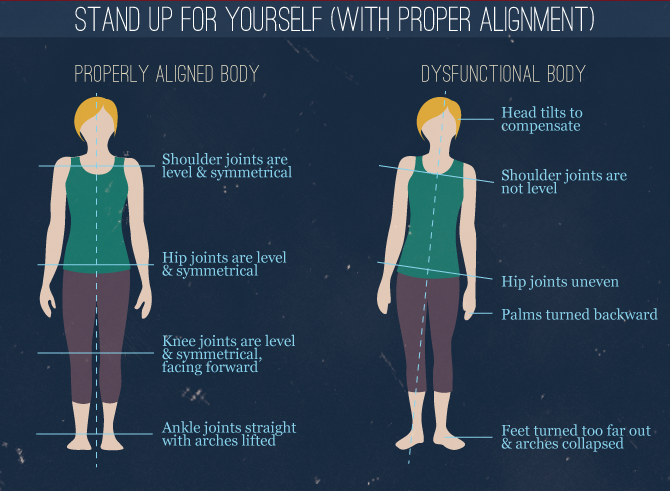
Proper alignment comes with a balance of muscle tension and strength. Ideal range-of-motion for any joint is allowed based on the muscle tension. Each joint has a normal range of motion.
Here are the normal movement patterns for each joint of the body. Keep in mind, when you are unable to move freely in the “normal ranges” you have a greater chance of injury.
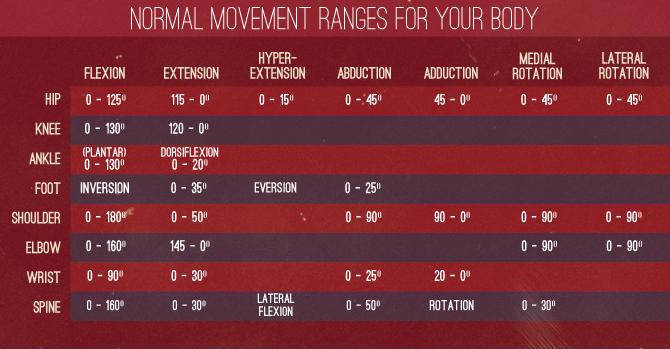
Understanding how the body should move and how it moves can help alleviate pain and re-establish better functional movements.
When a joint does not have the normal range of motion and it is not a result of surgery or a trauma incident, it comes down to the “strings” pulling on the body – the muscles.
Consider the spine for forward flexion. With a normal range of motion, forward flexion would allow one to bend at the waist and touch the toes. According to an LA-Fitness-published research study of its members’ physical assessments, less than half of the people could touch their toes without bending their knees. This lack of flexibility has a direct relationship with the strength of the hamstrings and glutes (muscles on the backside of the body that connect the legs to the spine) and their strength. If the hip flexors are stronger than the hamstrings, the body will not be able to fully move into a forward flexed position, making the spine more vulnerable and increasing the likelihood of injury if someone tried to move into this position or continued this misalignment for weeks, months, or years.
The best way to prevent and alleviate back pain is to increase flexibility through strengthening and stretching exercises as well as maintaining a healthy body weight and eating an anti-inflammatory diet.
Strengthening and stretching
Although many people will stretch to try to gain flexibility, the only way to keep flexibility is through muscle strengthening. Hence, to gain a greater range of motion in the hamstrings to be able to touch the toes, you would need to stretch the connective tissues and muscles including the IT band, hip rotators, hip flexors, and quadriceps (the front and side of the thighs), then strengthen the muscles that are holding you back. These would include the hamstrings and gluteal muscles.
1) IT Band Stretch. Start standing and cross your right foot behind the left. Next lean over, reaching down past the side of the knee and aim your elbow up towards the ceiling. Hold this stretch for 10-30 seconds while breathing. Repeat on the other side. Conscious breathing helps the body remember the patterns and muscle tension.
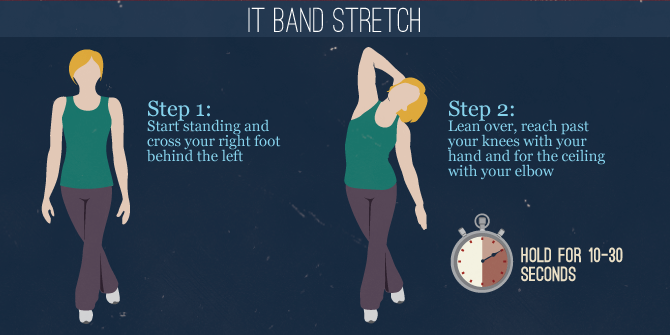
2) Crossed Knee Stretch. The hip rotators play a role in back health by stabilizing the pelvis. Start in a seated position and cross one knee over the other. Gently lean forward from the hips keeping your back straight and hold for 10-30 seconds. Repeat on the other side.
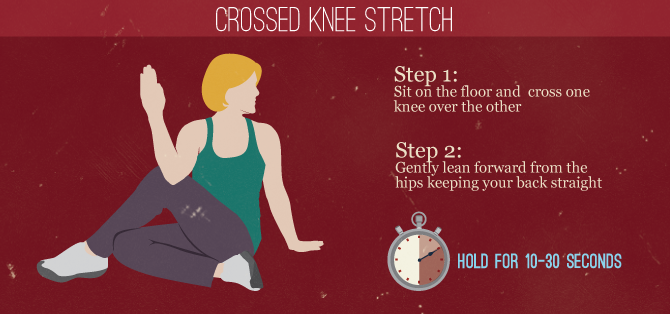
3) Split Lunge Stretch. Start in a split stance with back toes slightly turned inward and front knee bent. Lift arms upward and press hips forward by squeezing the glutes. Hold for 10-30 seconds and repeat on the other side. This helps open the hip flexors, which become tight from many hours of sitting, or from overuse patterns common in runners or bikers.
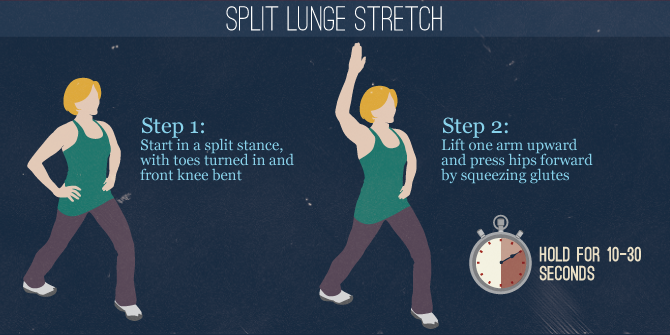
4) Knee Balance Stretch. Stand on one leg while bringing the heel up towards the backside of the body. You may hold onto a chair for support and to help maintain balance. Squeeze the hips forward to feel a stretch in the front of the thigh. Hold for 10-30 seconds and repeat on the other side. This helps open the quadriceps; a dominant frontal movement muscle group.
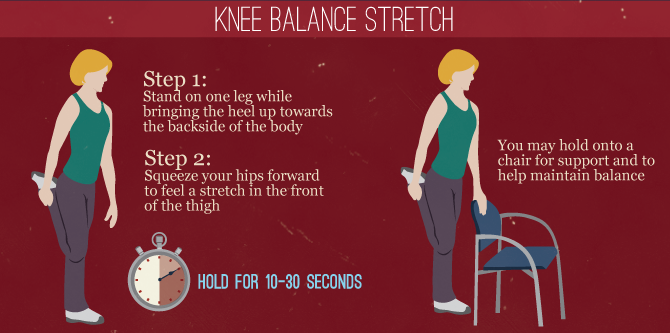
Stretching alone will not maintain flexibility. The sensory mechanisms in the body will soon realize the strength relationship in that area cannot maintain that range of motion. It is common to disregard the strengthening exercises that are crucial to maintaining lower back stability and range of motion. Here are some exercises to implement into a daily program.
1) Bridge. Start on the floor with knees bent, facing upward. Slowly tilt the pelvis towards the rib cage to create a rolling movement of the spine towards the ceiling and hold the hips up for three to five seconds. Then slowly lower the hips to the floor. Perform 15-20 repetitions.
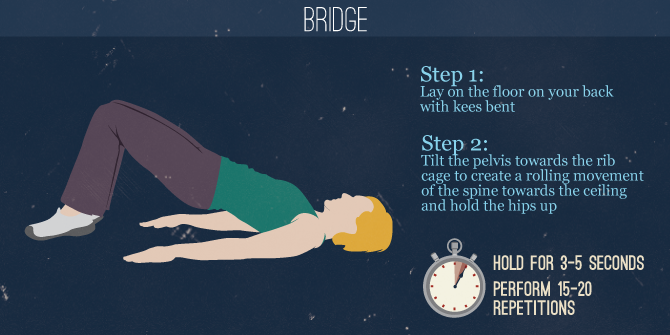
2) Hamstring Curls. Start with feet on a large stability ball, knees bent, while lying on the ground with your hands at your side. Slowly lift the hips and then roll the ball away from the body and towards the body. Then lower hips to the floor. Continue to perform 15-20 repetitions until this exercise becomes easier. Then keep hips up in the air as you roll the ball to and from the body for a more challenging exercise.
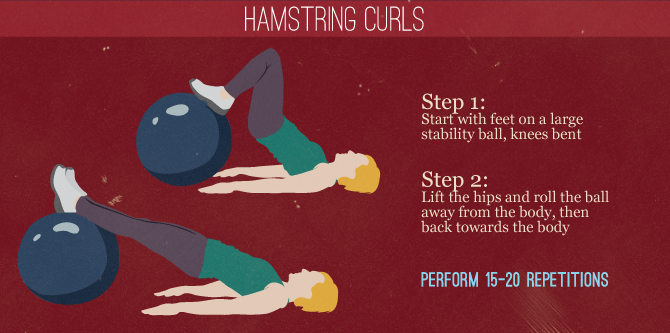
3) Superman. Hip extension helps strengthen the glutes, but keep in mind that the pelvis must stay neutral. Start facing down lying on the floor with arms and legs extended. Lift the arms two to four inches off the ground at the same time as lifting the legs. Try to hold this position for 30 seconds and up to one minute. Then repeat the movement.

These simple strengthening exercises combined with the above stretches will help prevent and may alleviate lower back pain. It’s important to perform this routine three to five times per week, in addition to maintaining a healthy weight and an anti-inflammatory diet.
Embed the article on your site

